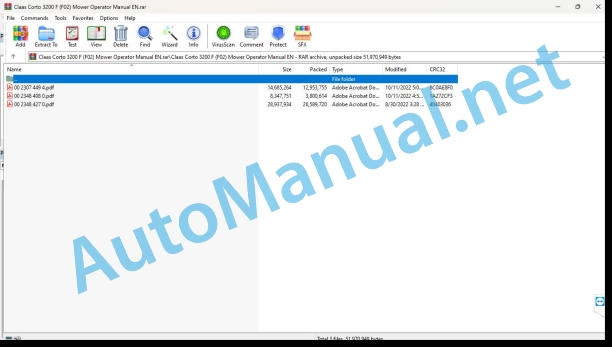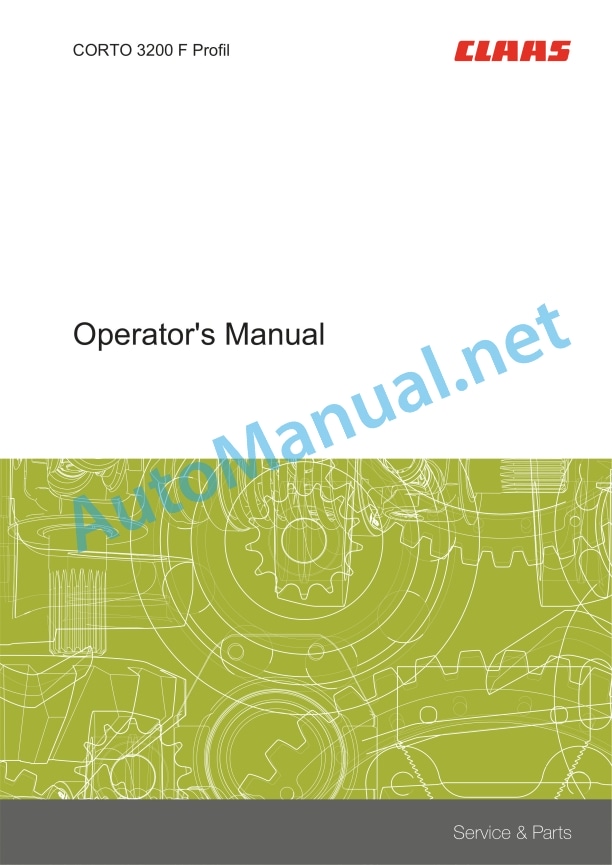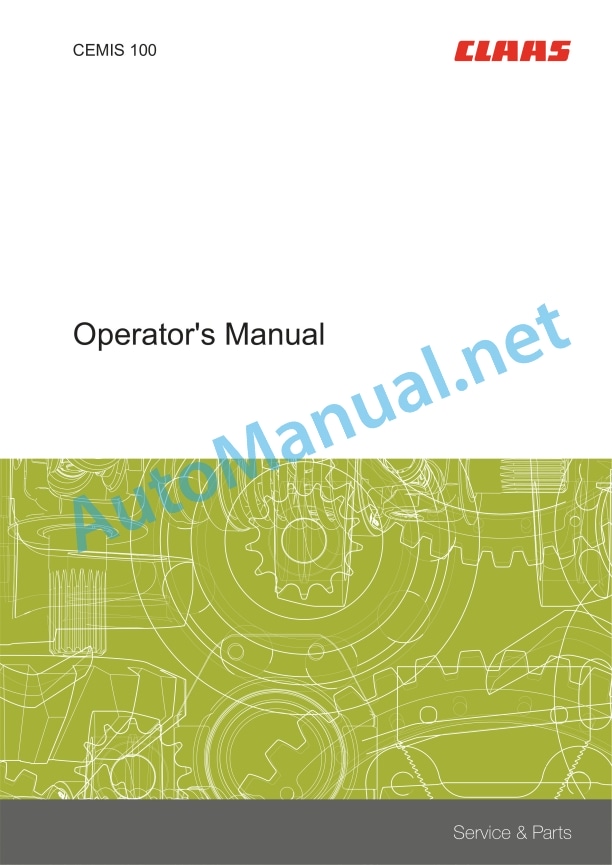Claas Corto 3200 F (F02) Mower Operator Manual EN
$50.00
- Model: Corto 3200 F (F02) Mower
- Type Of Manual: Operator Manual
- Language: EN
- Format: PDF(s)
- Size: 41.3 MB
File List:
00 2307 449 4.pdf
00 2348 408 0.pdf
00 2348 427 0.pdf
00 2307 449 4.pdf:
CORTO 3200 F Profil
Table of contents
1 Introduction
1.1 Notes on the manual
1.1.1 Validity of the manual
1.1.2 Information about this Operator’s Manual
1.1.3 Symbols and notes
1.1.4 Optional equipment
1.1.5 Qualified specialist workshop
1.1.6 Maintenance notes
1.1.7 Warranty notes
1.1.8 Spare parts and technical questions
1.2 Intended use
1.2.1 Intended use
1.2.2 Reasonably foreseeable misuse
2 Safety
2.1 Identifying warnings
2.1.1 Hazard signs
2.1.2 Signal word
2.2 Safety rules
2.2.1 Importance of Operator’s Manual
2.2.2 Observing safety decals and warnings
2.2.3 Requirements for all persons working with the machine
2.2.4 Children in danger
2.2.5 Hazard areas
2.2.6 Presence between tractor and machine
2.2.7 Hitching the tractor to the machine
2.2.8 Danger of injury from rotating shafts
2.2.9 Structural alterations
2.2.10 Optional equipment and spare parts
2.2.11 Control of the machine while it is running
2.2.12 Operation only after proper putting into operation
2.2.13 Technical condition
2.2.14 Danger from damage to the machine
2.2.15 Complying with technical limit values
2.2.16 Danger from continued running of machine parts
2.2.17 Keeping safety devices functional
2.2.18 Personal protective equipment
2.2.19 Wearing suitable clothing
2.2.20 Removing dirt and loose objects
2.2.21 Preparing the machine for road travel
2.2.22 Risks when driving on the road and in the field
2.2.23 Parking the machine safely
2.2.24 Unsupervised parking
2.2.25 Unsuitable operating utilities
2.2.26 Safe handling of operating and auxiliary utilities
2.2.27 Environmental protection and disposal
2.2.28 Fire prevention
2.2.29 Lethal electrocution from overhead lines
2.2.30 Behaviour in case of voltage flash-over from overhead lines and when lightning strikes
2.2.31 Noise may cause health damage
2.2.32 Pressurised fluids
2.2.33 Hot surfaces
2.2.34 Working on machine only after shutting it down
2.2.35 Maintenance work and repairs
2.2.36 Raised machine parts and loads
2.2.37 Danger from welding work
2.3 Safety decals on the machine
2.3.1 Structure of safety decals
2.3.2 Safety decals on the machine
3 Machine description
3.1 Overview and method of operation
3.1.1 Machine overview
3.1.2 Function
3.2 Optional equipment
3.2.1 Additional swath discs*
3.2.2 Three-point extension*
3.2.3 Infinitely adjustable cutting height*
3.2.4 Hydraulic front load relief
3.2.5 Glide disc height increase for high-cut operations*
3.2.6 Leaf springs with hard coating*
3.2.7 Spacer rings for high-cut operations*
3.2.8 Catch belts*
3.2.9 Slip-on yoke for 8-piece universal drive shaft*
3.2.10 Hydraulically folding safety frames*
3.2.11 Double mirror*
3.2.12 Warning plates with lighting*
3.2.13 Legal equipment for France*
3.2.14 Legal technical equipment for Italy*
3.2.15 Hydraulic set for AXION 800 with five-tonne power lift*
3.3 Identification plates and identification numbers
3.3.1 Machine identification plate
3.4 Information on the machine
3.4.1 Stickers on the machine
4 Operating and display elements
4.1 Controls
4.1.1 Attachable frame
4.2 Display elements
4.2.1 Hydraulic front load relief
5 Technical specifications
5.1 CORTO 3200 F Profil
5.1.1 Dimensions
5.1.2 Weights
5.1.3 Requirements for the tractor
5.1.4 Version
5.1.5 Sound pressure level
5.1.6 Lubricants
6 Machine preparation
6.1 Switching off and securing the machine
6.1.1 Switching off and securing the tractor and machine
6.1.2 Securing the raised machine
6.2 Adapting the tractor
6.2.1 Checking the ballasting of the tractor
Calculating the minimum front ballast
Calculating the minimum rear ballast
Calculating the actual front axle load
Calculating the actual total weight
Calculating the actual rear axle load
Calculation table
6.2.2 Checking the protective guard on the tractor PTO shaft
6.2.3 Adjusting the front power lift
6.2.4 Attaching the three-point extension*
6.2.5 Fitting the holders for the floatation springs
6.2.6 Fitting the plates for the load relief springs
6.2.7 Attaching the holder for hydropneumatic mower suspension*
6.2.8 Attaching the plates for hydropneumatic mower suspension*
6.3 Adapting the machine
6.3.1 Checking the universal drive shaft length
Shortest working position of the universal drive shaft
Longest working position of the universal drive shaft
6.3.2 Adapting the universal drive shaft length
6.3.3 Adjusting the hydraulic front load relief*
6.3.4 Fitting the catch belt*
6.3.5 Fitting the lateral offset
6.4 Hitch the machine
6.4.1 Accommodating the machine
6.4.2 Adjusting the plate on the hitch block
6.4.3 Installing the universal drive shaft
6.4.4 Adjusting the upper link
6.4.5 Checking the free space of universal drive shaft
6.4.6 Checking the free space of universal drive shaft
6.4.7 Fitting the floatation springs
6.4.8 Fitting the hydraulic front load relief*
Checking the fitting position
6.4.9 Attaching the hydraulically folding safety frame*
6.4.10 Hooking in the safety guard
6.4.11 Plugging in the lighting cable*
6.5 Unhitching the machine
6.5.1 Unhinge the suspension springs
6.5.2 Unplugging the lighting cable*
6.5.3 Detaching the safety guard
6.5.4 Removing the hydraulic front load relief*
6.5.5 Disconnecting the hydraulically folding safety frames*
6.5.6 Removing the universal drive shaft
6.5.7 Setting down the machine
6.6 Prepare road travel
6.6.1 Marking the machine for road travel
6.6.2 Folding the safety guards up
6.6.3 Raising to the transport position
6.7 Preparing fieldwork
6.7.1 Folding the safety guards down
6.8 Loading the machine
6.8.1 Loading and unloading the machine
7 Operation
7.1 Driving on the road
7.1.1 Driving on public roads
7.2 Fieldwork settings
7.2.1 Adjusting the swath width
7.2.2 Adjusting the additional swathing discs*
7.2.3 Setting the infinitely adjustable cutting height*
7.3 Fieldwork
7.3.1 To be observed during fieldwork
7.3.2 Machine use
7.3.3 Mowing methods
7.3.4 Instructions for mowing
7.3.5 Difficult operating conditions
7.3.6 Recommendation for environmental protection
8 Faults and remedies
8.1 Overview of problems
8.1.1 Problems on the machine
8.2 Electric system
8.2.1 Lighting equipment defective
9 Maintenance
9.1 Maintenance interval overview
9.1.1 Before the harvest
9.1.2 After the first 10 operating hours
9.1.3 After the first 50 operating hours
9.1.4 Every 8 operating hours
9.1.5 Every 50 operating hours
9.1.6 Every 100 operating hours
9.1.7 Every 250 operating hours
9.1.8 Every 500 operating hours or annually
9.1.9 Every 5 years
9.1.10 After the harvest
9.2 Gearbox
9.2.1 Checking the gearbox for leaks
9.2.2 Checking the oil level in the angle drive
9.2.3 Change the oil in the angle drive
9.3 Universal drive shaft
9.3.1 Servicing the universal drive shafts
9.4 Drives
9.4.1 Checking the drive belt
9.4.2 Tensioning the drive belt
9.4.3 Changing the drive belts
9.5 Hydraulic system
9.5.1 Reducing the pressure in the hydraulic system
9.5.2 Checking the hydraulic hoses
9.5.3 Checking the accumulator*
9.6 Mower unit
9.6.1 Checking the oil level of the mowing drum frame
9.6.2 Checking the oil level of the mowing drum frame
9.6.3 Changing the oil in the mowing drum frame
Draining oil
Topping up oil
9.6.4 Removing the mower knife box
9.6.5 Check the mower knives
9.6.6 Replacing the mower knives
9.6.7 Checking the mower knife holder
9.6.8 Adjust the longitudinal levelling of the mower
Adjusting the compression spring
Adjusting the tension springs
9.6.9 Adjusting the lateral levelling of the mower
9.6.10 Greasing the infinitely adjustable cutting height system*
9.7 Fodder discharge / swath discharge
9.7.1 Checking the swathing plates
9.7.2 Adjusting the swath discs
Basic setup
Adjusting the clearance between the swath disc and drum/cutting disc
Aligning the additional swath disc*
Clearance of additional swath disc* from the ground
9.8 Assembly parts and machine body
9.8.1 Checking the safety guards
9.8.2 Check the safety guard holder
9.8.3 Checking the safety guard bracket
9.8.4 Removing crop residues
9.8.5 Clean the machine
9.8.6 Preserve the machine
9.8.7 Check the fittings
9.9 Lubrication chart
9.9.1 Lubricate lubrication points every 50 operating hours
9.9.2 Lubricating grease points every 100 operating hours
9.9.3 Lubricating grease points every 250 operating hours
9.9.4 Lubricate grease points every 500 operating hours
10 Putting out of operation and disposal
10.1 General information
10.1.1 Removal from service and disposal
11 EC declaration of conformity
11.1 CORTO 3200 F Profil
11.1.1 UK declaration of conformity
11.1.2 EC Declaration of Conformity
12 Technical terms and abbreviations
12.1 Terms and explanations
12.1.1 Technical terms
12.1.2 Abbreviations
00 2348 408 0.pdf:
CEMIS 100
Table of contents
1 Introduction
1.1 General information
1.1.1 Validity of the manual
1.1.2 Information about this Operator’s Manual
1.1.3 Symbols and notes
1.2 Intended use
1.2.1 Intended use
1.2.2 Reasonably foreseeable misuse
2 Safety
2.1 Safety rules
2.1.1 General safety and accident prevention regulations
2.1.2 Interaction between terminal and machine or tractor
2.1.3 Electrocution by electrical system
3 Product description
3.1 Overview and method of operation
3.1.1 Overview of CEMIS 100
3.1.2 Function principle of CEMIS 100
3.2 Identification plates and identification numbers
3.2.1 Spare parts and technical questions
3.2.2 Identification plate of CEMIS 100
4 Operating and display elements
4.1 CEMIS 100
4.1.1 User interface for LINER
4.1.2 User interface for ROLLANT
4.1.3 User interface for UNIWRAP
5 Technical specifications
5.1 CEMIS 100
5.1.1 Specification
6 Operation
6.1 CEMIS 100
6.1.1 Operating the CEMIS 100
6.1.2 Switching CEMIS 100 on
6.1.3 Switching CEMIS 100 off
7 Maintenance
7.1 CEMIS 100
7.1.1 Daily
8 Putting out of operation and disposal
8.1 General information
8.1.1 Removal from service and disposal
9 Technical terms and abbreviations
9.1 Terms and explanations
9.1.1 Technical words
9.1.2 Abbreviations
00 2348 427 0.pdf:
CEMIS 700
Table of contents
1 Introduction
1.1 General information
1.1.1 Validity of the manual
1.1.2 Information about this Operator’s Manual
1.1.3 Symbols and notes
1.2 Intended use
1.2.1 Intended use
1.2.2 Reasonably foreseeable misuse
2 Safety
2.1 Safety rules
2.1.1 General safety and accident prevention regulations
2.1.2 Interaction between terminal and machine or tractor
2.1.3 Electrocution by electrical system
3 Product description
3.1 Overview and method of operation
3.1.1 Overview of CEMIS 700
3.1.2 Function principle of CEMIS 700
3.2 Identification plates and identification numbers
3.2.1 Spare parts and technical questions
3.2.2 Identification plate of CEMIS 700
4 Information on the product
4.1 Software version
5 Operating and display elements
5.1 CEMIS 700
5.1.1 User interface
5.1.2 Terminal program
6 Technical specifications
6.1 CEMIS 700
6.1.1 Specification
7 Operation
7.1 CEMIS 700
7.1.1 Operating the CEMIS 700
7.1.2 Switching CEMIS 700 on
7.1.3 Switching CEMIS 700 off
7.2 Terminal settings
7.2.1 Making settings
Making settings with the rotary button
Making settings with the touch function
7.2.2 Setting the screen lighting
Daytime mode
Nighttime mode
Activating automatic key lighting
7.2.3 Setting the time and date
7.2.4 Displaying diagnosis information
On-board power supply voltage display
Display of CLAAS ISOBUS ECU address and name
7.2.5 Setting the language and display formats
Setting the language
Setting display formats
7.2.6 Setting the volume
7.2.7 Deleting an ISOBUS implement
8 Maintenance
8.1 Maintenance
8.1.1 Daily
9 Putting out of operation and disposal
9.1 General information
9.1.1 Removal from service and disposal
10 Technical terms and abbreviations
10.1 Terms and explanations
10.1.1 Technical words
10.1.2 Abbreviations
John Deere Repair Technical Manual PDF
John Deere Repair Technical Manual PDF
John Deere Repair Technical Manual PDF
John Deere Parts Catalog PDF
John Deere Tractors 6300, 6500, and 6600 Parts Catalog CQ26564 (29SET05) Portuguese
John Deere Repair Technical Manual PDF
John Deere 16, 18, 20 and 24HP Onan Engines Component Technical Manual CTM2 (19APR90)
John Deere Repair Technical Manual PDF
John Deere Repair Technical Manual PDF
John Deere 18-Speed PST Repair Manual Component Technical Manual CTM168 10DEC07
New Holland Service Manual PDF
























